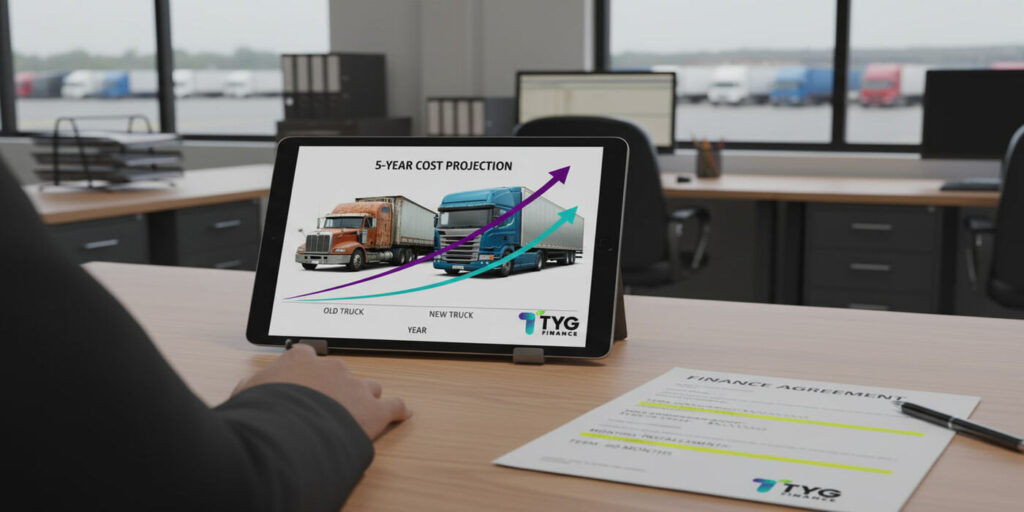Looking Beyond the Purchase Price
Fleet replacement planning is one of the most consequential decisions for operators in transport, mining, agriculture, and construction. The vehicles and equipment you choose directly influence cost structures, safety outcomes, and long-term competitiveness.
Yet when it comes time to replace or upgrade, many operators still default to comparing sticker prices alone. While initial cost matters, it is only one piece of a much larger puzzle. Total cost of ownership (TCO), duty cycle demands, and the value of driver safety initiatives often hold equal, if not greater, weight in the decision-making process.
This article offers a series of insights asset-backed operators may wish to consider when framing their fleet replacement strategy.
Insight 1: Sticker Price Rarely Tells the Full Story
It can be tempting to focus on purchase price, especially when comparing new versus used vehicles or considering different brands. However, upfront savings may erode quickly if the vehicle comes with higher operating expenses.
Factors often overlooked when focusing solely on sticker price include:
- Fuel efficiency and energy use across different vehicle types.
- Maintenance trajectories, as some vehicles age more predictably than others.
- Depreciation rates, which can affect resale or trade-in value.
- Insurance premiums, often higher for older or less safety-equipped assets.
Operators weighing replacement options often find that a higher purchase price can equate to a lower total cost of ownership when the full lifecycle is considered. Additionally, applying a proactive maintenance regime is one of the most effective ways to keep lifecycle costs predictable.
Explore tailored options through our Business Vehicle Finance solutions.
Insight 2: TCO Provides a Holistic Lens
Total cost of ownership is increasingly used as the benchmark for smart fleet planning. By accounting for every major cost category, TCO analysis helps avoid surprises and aligns investment with long-term value.
A simple comparison of two vehicles might look like this:
| Category | Vehicle A (Lower Sticker Price) | Vehicle B (Higher Sticker Price) |
|---|---|---|
| Initial Cost | $60,000 | $80,000 |
| Maintenance (5 yrs) | $45,000 | $25,000 |
| Fuel (5 yrs) | $70,000 | $50,000 |
| Safety Tech | Basic | Advanced |
| Resale Value | $15,000 | $30,000 |
| Total TCO | $160,000 | $145,000 |
This example illustrates how TCO can challenge assumptions and highlight the long-term financial impact of fleet decisions.
Learn how broader fleet strategies can be supported with our Fleet Finance solutions.
Insight 3: Duty Cycles Shape Replacement Timing
Another factor that can significantly influence fleet replacement decisions is the duty cycle. A vehicle clocking hundreds of kilometres daily in metropolitan delivery schedules will experience wear and tear at a different rate than one used occasionally in regional agriculture.
Duty cycle management often affects:
- Replacement frequency: High-intensity usage can shorten the replacement cycle.
- Maintenance intervals: Vehicles under heavy strain typically require more rigorous upkeep.
- Residual value: Vehicles with intense duty cycles often depreciate faster.
By aligning replacement planning with duty cycle realities, operators may better balance operational reliability with financial efficiency. For asset-heavy industries, developing the right replacement plan starts with understanding how fleet management strategies balance long-term costs and operational safety.
Insight 4: Safety Investments Can Deliver ROI
While driver safety initiatives are sometimes viewed as added costs, many operators now frame them as strategic investments. Safer fleets can reduce accidents, limit downtime, and even lower insurance premiums.
Considerations in this area might include:
- Upgrading to vehicles with advanced driver assistance systems (ADAS).
- Telematics and monitoring systems that provide real-time insights into driver behaviour.
- Structured safety training to reduce incidents of fatigue or distraction.
A 2024 transport industry report suggested that fleets integrating safety technology alongside driver training programs saw measurable reductions in accident-related costs over a three-year period. Practical upgrades such as improved safety technology and in-cab monitoring can transform fleet efficiency and help owners see measurable ROI quickly.
Insight 5: Financing Structures Can Support Smarter Choices
Even with the right strategy, funding fleet replacement can present challenges. This is where financing options may provide an important lever. Rather than committing large amounts of capital upfront, businesses can align repayments with operational cash flows and replacement schedules.
Potential benefits include:
- Flexibility to replace vehicles gradually instead of all at once.
- Ability to invest in safety-equipped vehicles without delaying due to capital constraints.
- Predictable repayment structures that make long-term planning easier.
Some operators find that combining Fleet Finance facilities for large-scale replacement with Business Vehicle Finance for individual acquisitions offers the balance they need to stay agile. Additionally, aligning repayment structures with seasonal cash flow cycles lets operators plan upgrades without stretching resources during busy periods.
The Broader Industry Context
Fleet replacement planning is not happening in a vacuum. Industry benchmarks and analytics services consistently highlight the importance of considering lifecycle costs, safety, and operational impact.
- Transport industry reports often emphasise the correlation between modernised fleets and compliance outcomes.
- Financial analytics services regularly point to the benefits of using data-driven models to evaluate asset performance and replacement timing.
Operators who stay informed through these channels may find themselves better prepared to adapt to shifting regulations and cost pressures.
Practical Takeaways for Operators
- Evaluate both sticker price and TCO before making replacement decisions.
- Align fleet replacement planning with duty cycle realities.
- Treat driver safety investments as potential ROI enhancers, not sunk costs.
- Use financing structures to smooth capital demands and retain flexibility.
- Leverage industry reports and analytics to stay ahead of emerging benchmarks.
Framing Smarter Decisions for Long-Term Valu
Fleet replacement planning is as much about mindset as it is about numbers. By looking beyond sticker price, considering total cost of ownership, factoring in safety, and tailoring decisions to duty cycles, operators can frame smarter strategies that support both efficiency and resilience.
Finance plays an enabling role in this process — not as an afterthought, but as a strategic tool to align investment with business objectives.
Begin your finance journey with TYG Finance and explore flexible options for your next fleet decision.


